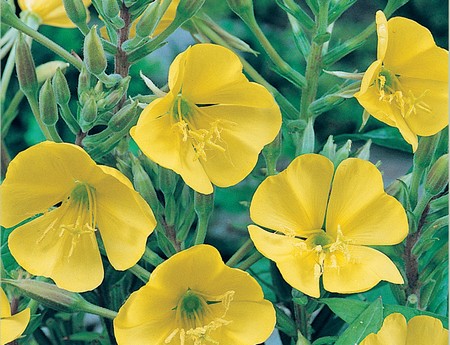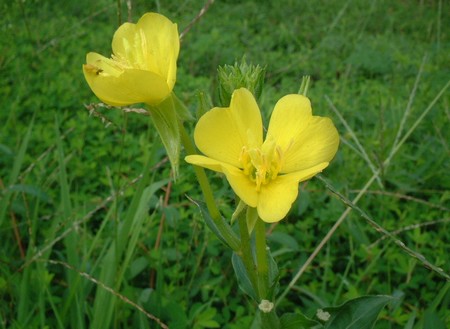Evening primrose is a tall elegant plant with large fragrant cup-shaped yellow flowers that generally open at dusk (or on very cloudy days), attracting the night-flying moths and insects which pollinate them. Evening primrose flourishes throughout Europe, and both North and South America. It grows wild on disturbed ground, and makes a colourful plant for the back of garden border.
Evening primrose was known to the Ancient Greeks, and Theophrastus (350BC) gave the flower its generic name which is derived from oinos meaning wine and thera meaning hunt, in reference to the plant’s power to stimulate a desire for wine, or its power to dispel the effects of over-indulgence.
Traditionally evening primrose was valued as an edible wild plant. The seeds were used as food by native Americans in Utah and Nevada and the young leaves have been enjoyed in salads. Evening primrose is a biennial, and in the first year it grows a fleshy root which was boiled as a nutty-tasting vegetable.
Herbal remedy
The outer flower stems and leaves are highly mucilaginous and make a lotion to soothe skin eruptions, and internally soothe an irritated digestive tract and treat diarrhoea. A mild sedative, it relieves nervous indigestion and colic. Its antispasmodic effects help with asthma and whooping cough.
Until recently the leaves and outer stem were the only parts used medicinally, apart from the root that was eaten. Since then a vast amount of research has been done on the medicinal effect of the oil extracted from the seeds which has made evening primrose one of the most valuable remedies from nature. The oil is a good source of Omega 6 fatty acids, vital for healthy functioning of the immune, nervous and hormonal systems. It is one of the few oils that contain gamma linoleic acid (GLA), a fatty acid that is normally produced in the body as an intermediate step during the metabolism of linoleic acid, a fatty acid from other sources such as sunflower seeds. A breakdown in the production of GLA from linoleic acid is related to problems such as eczema and PMS, and thus evening primrose oil provides an excellent way to remedy such metabolic errors. Evening primrose oil has been found to be extremely valuable in the treatment of PMS, breast and menopausal problems, hyperactivity in children, eczema, acne, asthma, migraine, metabolic disorders, arthritis and a whole range of allergies. It counteracts the effect of alcoholic poisoning and encourages regeneration of a damaged liver. It can help with withdrawal from alcohol and alcoholic depression. Further studies indicate a role in treating multiple sclerosis, high blood pressure and to help prevent high cholesterol, clotting of the blood and coronary artery disease.
Homeopathic remedy: Oenothera biennis
The fresh flowers, leaves and stems of Oenothera biennis are used in homeopathic preparations and treat watery diarrhoea that passes without effort and is accompanied by exhaustion. There may be abdominal and other cramps. The symptoms also indicating Oenothera include dizziness, light-headedness, great weakness, numbness and pricking of the skin, fluttering in the heart, and fever with rigors.
The flower essence
The flower remedy O. hookeri is recommended for people who suffer from feeling rejected or unwanted, often due to childhood problems; perhaps they lacked proper emotional support or love or did not bond closely with their mother during infancy.
Such people tend to avoid close emotional contact, intimacy and committed relationships, due to fear of rejection. Evening primrose helps to heal feelings of rejection and feeling unlovable and enables one to be more open emotionally and to form deeper relationships.

